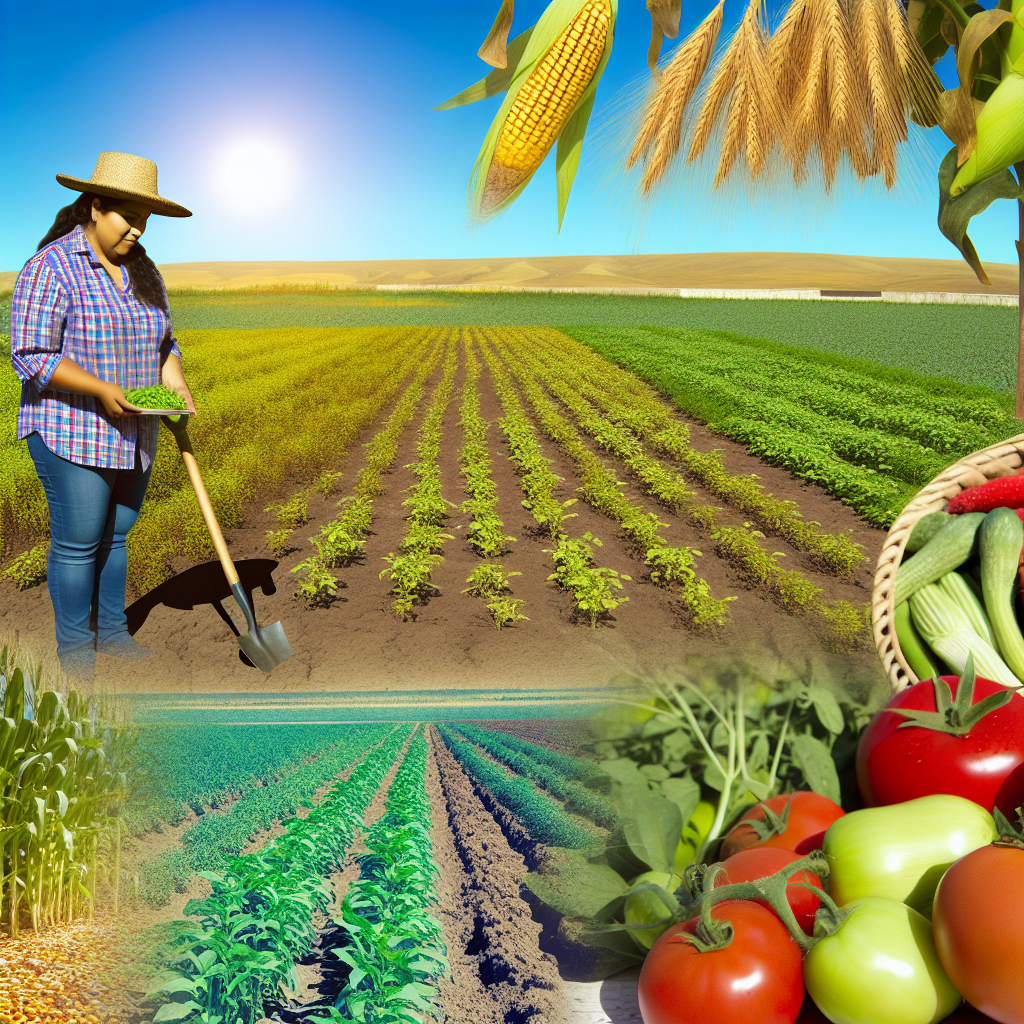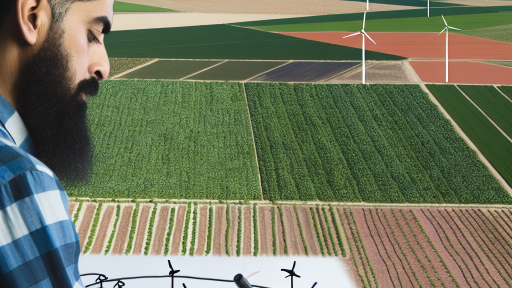Introduction to Biodiversity and Its Importance in Agriculture
Biodiversity plays a crucial role in agricultural systems.
It includes the variety of life forms in ecosystems.
This variety contributes to ecosystem resilience and stability.
Farmers benefit from higher productivity with diverse crops.
Diverse ecosystems can better withstand pests and diseases.
Additionally, biodiversity improves soil health and fertility.
Healthy soils support vibrant plant growth and nutrient cycling.
Contribution to Ecosystem Services
Biodiversity enhances various ecosystem services.
It supports pollination, which boosts crop yields.
Furthermore, diverse species aid in pest regulation.
This natural pest control reduces the need for harmful chemicals.
Consequently, farmers can achieve sustainable farming practices.
Moreover, diverse landscapes protect against soil erosion.
Adaptation to Climate Change
Biodiversity fosters resilience against climate change impacts.
Having multiple crop varieties allows adaptation to changing conditions.
Transform Your Agribusiness
Unlock your farm's potential with expert advice tailored to your needs. Get actionable steps that drive real results.
Get StartedFor instance, some varieties may tolerate drought better than others.
Additionally, genetic diversity enhances disease resistance.
This ensures crops survive unpredictable weather patterns.
Economic Benefits of Biodiversity
Diverse agricultural systems often lead to better economic returns.
Farmers can market unique crops that command higher prices.
This diversity attracts wider consumer preferences and demands.
Moreover, sustainable practices contribute to long-term profitability.
Investing in biodiversity today secures resources for future generations.
The Role of Diverse Cropping Systems in Improving Soil Health
Importance of Biodiversity
Diverse cropping systems enhance soil organisms and ecosystem functions.
This biodiversity aids in nutrient cycling and organic matter decomposition.
As a result, soil structure and fertility improve significantly.
Reduction of Soil Erosion
Planting a variety of crops decreases soil erosion rates.
Root systems stabilize the soil while reducing water runoff.
This leads to better water retention and nutrient absorption.
Pest and Disease Management
Crop diversity helps manage pests and diseases effectively.
Different plants can disrupt pest life cycles and reduce outbreaks.
Additionally, beneficial organisms flourish in diverse environments.
Enhanced Resilience to Climate Variability
Diverse cropping systems increase resilience against climate changes.
They can adapt to extreme weather conditions more efficiently.
This adaptability supports consistent yield levels across seasons.
Soil Health Indicators
Measuring soil health requires evaluating various indicators.
- Organic matter content indicates nutrient availability.
- Soil texture affects water retention and aeration.
- Microbial activity shows the ecosystem’s vitality.
Preserving these indicators is vital for sustainable agriculture.
Benefits of Intercropping and Crop Rotation for Enhanced Yields
Introduction to Intercropping
Intercropping involves growing two or more crops simultaneously in the same field.
This method maximizes the use of available resources.
Showcase Your Farming Business
Publish your professional farming services profile on our blog for a one-time fee of $200 and reach a dedicated audience of farmers and agribusiness owners.
Publish Your ProfileIt enhances biodiversity within farming systems.
Farmers can achieve better pest control and weed management through intercropping.
Advantages of Intercropping
Intercropping increases yield stability during unpredictable weather conditions.
Diverse crops can attract beneficial insects that control pests.
Additionally, intercropping reduces the risk of total crop failure.
By utilizing different root systems, crops access various soil nutrients more effectively.
Introduction to Crop Rotation
Crop rotation involves changing the type of crop grown in a specific field each season.
This practice breaks pest and disease cycles.
Crop rotation improves soil health by alternating deep and shallow rooting plants.
Thus, it enhances soil fertility over time.
Advantages of Crop Rotation
Crop rotation reduces reliance on chemical fertilizers and pesticides.
It allows farmers to manage nutrient depletion in the soil effectively.
This method promotes a more balanced ecosystem in agricultural landscapes.
Rotating crops also helps control weeds by disrupting their growth patterns.
Combining Intercropping and Crop Rotation
Combining these methods can create a resilient agricultural system.
Farmers can optimize land use and reduce input costs significantly.
Moreover, this combination fosters greater biodiversity in farms.
The result is improved crop yields and sustainable farming practices.
Implications for Enhanced Yields
Implementing intercropping and crop rotation proves beneficial for farmers.
Both practices contribute to enhanced yields and soil health.
Farmers who adopt these strategies can enhance their productivity sustainably.
See Related Content: Conservation Tillage Practices to Preserve Soil Moisture
Utilizing Native Plants for Pest Management and Pollinator Support
Benefits of Native Plants
Native plants play a crucial role in supporting local ecosystems.
They adapt better to the local climate and soils.
Additionally, native species require less water and fertilizer.
This makes them more sustainable compared to non-native plants.
Moreover, they provide habitat and food for wildlife.
Pest Management Strategies
Integrating native plants can enhance natural pest management.
For instance, some native plants attract beneficial insects.
Ladybugs and lacewings can help reduce pest populations.
Planting aromatic herbs can deter harmful insects.
Examples include basil, mint, and rosemary.
Supporting Pollinators
Native plants are essential for pollinator health and diversity.
They offer nectar and pollen, which are crucial food sources.
Studies show that diverse flowerings support more pollinator species.
Examples of great native pollinator plants include coneflowers and milkweeds.
Additionally, maintaining a variety of blooming periods is important.
Implementation in Agricultural Practices
Farmers can easily introduce native plants into existing landscapes.
Using hedgerows or border plantings is an effective option.
This not only supports biodiversity but also enhances crop yields.
Showcase Your Farming Business
Publish your professional farming services profile on our blog for a one-time fee of $200 and reach a dedicated audience of farmers and agribusiness owners.
Publish Your ProfileMoreover, these strategies can reduce reliance on chemical pesticides.
Finally, engaging the local community can promote awareness and support.
Discover More: Integrating Carbon Sequestration into Farming Systems
Impact of Biodiversity on Resilience to Climate Change
Understanding Biodiversity’s Role
Biodiversity plays a crucial role in enhancing ecosystem resilience.
It contributes to the stability and productivity of agricultural systems.
Moreover, diverse ecosystems can better withstand climate variability.
Increased Resistance to Pests and Diseases
A diverse range of crops can reduce pest populations naturally.
Different plants may attract beneficial insects that control pests.
As a result, farmers can rely less on chemical pesticides.
This practice enhances both crop yields and environmental health.
Improved Soil Health
Biodiversity fosters healthier soil through various mechanisms.
Diverse plant roots contribute to better soil structure.
This diversity also enhances nutrient cycling in the soil.
Healthy soil supports robust crop growth and resilience.
Adapting to Climate Variability
Plant diversity allows farmers to adapt to changing weather patterns.
Some crops may perform well under drought conditions.
Others may thrive in increased rainfall situations.
This adaptability is vital for food security in unpredictable climates.
Enhancing Pollination Services
Biodiversity supports a variety of pollinators, critical for crop production.
Healthy ecosystems promote the presence of bees and butterflies.
These pollinators significantly boost crop yields and quality.
Furthermore, diverse flowering plants can attract and sustain them.
Supporting Ecosystem Services
Diverse agricultural systems provide essential ecosystem services.
These services include carbon sequestration and water filtration.
They also contribute to maintaining local climate conditions.
Ultimately, healthy ecosystems enhance agricultural resilience.
Encouraging Sustainable Practices
Emphasizing biodiversity encourages sustainable farming practices.
Farmers can integrate crop rotations and intercropping strategies.
These methods align agricultural production with environmental stewardship.
Consequently, they drive long-term productivity and resilience.
Delve into the Subject: Wildlife-Friendly Practices for Sustainable Farms

Case Studies: Successful Implementation of Biodiversity in Farming
Introduction to Case Studies
Case studies provide real-world examples of effective biodiversity strategies.
They illustrate how diverse farming methods enhance crop productivity.
Moreover, these examples highlight sustainable practices across various regions.
Agroforestry in Colombia
In Colombia, farmers employ agroforestry to boost yields.
This technique combines trees with crop production.
As a result, farmers experience improved soil quality.
Additionally, agroforestry promotes greater biodiversity.
Farmers like Miguel Ortiz reported a 30% increase in corn yields.
Key Benefits of Agroforestry
- Enhanced resilience to climate change
- Improved pest control through habitat diversification
- Higher levels of organic matter in soil
Polyculture Systems in Madagascar
Madagascar’s farmers practice polyculture for better results.
Showcase Your Farming Business
Publish your professional farming services profile on our blog for a one-time fee of $200 and reach a dedicated audience of farmers and agribusiness owners.
Publish Your ProfileThis system involves growing multiple crops together.
It leads to pest suppression and improved nutrient utilization.
For instance, farmers reported doubling their rice production using polyculture.
Advantages of Polyculture
- Increased crop resilience against diseases
- Maximized use of land and resources
- Encourages beneficial insect populations
Organic Farming in the Netherlands
The Netherlands demonstrates successful organic farming practices.
Farmers implement crop rotation and companion planting.
This method enhances soil fertility and reduces chemical reliance.
Farmers such as Anne van Dijk achieved a 25% yield increase in tomatoes.
Benefits of Organic Techniques
- Reduced costs of chemical inputs
- Improved market access for organic products
- Better environmental health and biodiversity
Community-led Initiatives in India
In India, community-based initiatives promote local biodiversity.
Farmers collaborate to create diverse cropping systems.
This approach enhances food security and local ecosystems.
Communities like those in Punjab have seen significant yield improvements.
Impact of Community Initiatives
- Strengthened local knowledge and practices
- Support for native crop varieties
- Fostering community resilience and adaptability
Find Out More: Natural Recycling Methods for Agricultural Waste
Challenges and Considerations in Promoting Biodiversity on Farms
Understanding the Barriers
Farmers face numerous challenges when promoting biodiversity.
One major barrier is limited financial resources.
Additionally, many farmers are unaware of biodiversity benefits.
This knowledge gap can hinder sustainable practices.
Furthermore, existing agricultural policies may not support biodiversity initiatives.
Managing Land Use Conflicts
Land use conflicts often arise in agricultural settings.
Farmers must balance productivity with ecological health.
This challenge requires careful planning and management.
Moreover, land fragmentation can complicate biodiversity enhancement efforts.
Connecting habitats through preservation strategies can mitigate this issue.
Addressing Soil Health and Pests
Soil health directly affects biodiversity and crop yields.
Farmers must adopt practices that support soil vitality.
This may include crop rotation and cover cropping methods.
Additionally, managing pest populations can become complicated.
Using pesticides can harm beneficial species vital for ecosystem balance.
Education and Community Engagement
Education plays a critical role in promoting biodiversity.
Farmers need access to information regarding sustainable practices.
Community engagement can facilitate knowledge sharing among farmers.
Workshops and resources can help disseminate best practices.
Furthermore, forming partnerships can enhance collaborative efforts.
Promoting Government Policies
Supportive government policies can significantly impact biodiversity efforts.
Incentives for sustainable farming practices are crucial.
Policy frameworks should prioritize local biodiversity initiatives.
Furthermore, funding for research and education can bolster farmer efficacy.
Advocacy groups can help shape favorable policies for biodiversity enhancement.
Future Trends: Integrating Technology to Monitor Biodiversity and Crop Yields
The Role of Technology in Agriculture
Technology significantly transforms agriculture today.
Farmers use various tools to enhance productivity.
Remote sensing offers valuable insights into biodiversity.
Showcase Your Farming Business
Publish your professional farming services profile on our blog for a one-time fee of $200 and reach a dedicated audience of farmers and agribusiness owners.
Publish Your ProfileSoil sensors provide real-time data for crop management.
Additionally, drones capture aerial imagery for analysis.
Data Analytics and Decision Making
Data analytics helps farmers make informed decisions.
Analyzing historical data reveals trends in crop yields.
Farmers can identify the best planting times through this method.
Predictive analytics assists in forecasting potential issues.
Consequently, proactive management strategies emerge.
Artificial Intelligence in Biodiversity Monitoring
Artificial Intelligence (AI) plays a crucial role in monitoring ecosystems.
Machine learning algorithms assess ecological data efficiently.
This technology identifies patterns that humans might overlook.
Agricultural AI improves pest management and reduction strategies.
Ultimately, it enhances overall sustainability in farming practices.
Integrating IoT for Comprehensive Monitoring
The Internet of Things (IoT) connects multiple devices on farms.
Sensors collect data on various environmental factors.
This includes temperature, humidity, and soil moisture levels.
Farmers receive insights straight to their mobile devices.
This integration leads to timely interventions and optimized practices.
Collaboration for Innovation
Collaboration between tech companies and farmers fosters innovation.
Startups and established firms focus on agricultural technology solutions.
Joint initiatives promote the development of sustainable practices.
Furthermore, workshops and training sessions enhance farmers’ tech skills.
As a result, farmers are better equipped to face future challenges.
Additional Resources
Achieving win-win outcomes for biodiversity and yield through …
Sustainable Agricultural Productivity Growth: What, Why and How …




